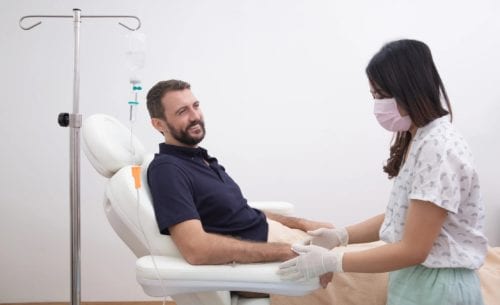
What is Infusion Therapy?
Infusion therapy is a form of alternative treatment in which medicine is injected into the bloodstream through a catheter in the arm, instead of taken orally. Traditionally, infusion therapy was administered solely at hospitals because the resources were unavailable elsewhere. However, infusion therapy centers and specially trained nurses are becoming increasingly available to perform infusion therapy treatments, allowing patients to receive this alternative form of medicine without making routine trips to the hospital.
From serious autoimmune disorders to cancers, administering medication intravenously bypasses the somewhat-slow digestive system and delivers medication quickly and efficiently.
Common medications delivered through infusion therapy include:
- Chemo drugs
- Antibiotics
- Antifungal medication
- Pain management medications (like hydromorphone and morphine)
What to Expect From Infusion Therapy and What Conditions it Treats
What to Expect during the procedure:
Infusion therapy isn’t as invasive as it sounds. A licensed nurse will insert a needle attached to a tube, into the patient’s veins, located in the arm or hand. The nurse will then hook the tube up to an IV bag full of fluids and medication, that gets slowly released into the bloodstream. Once the medication has been administered, the nurse removes the needle from your vein and applies a small bandage to cover the pin-prick size wound.
Who is a candidate for infusion therapy?:
Patients who can’t take oral medication or patients who have a disease that doesn’t respond well to oral medication are prime candidates for infusion therapies. Certain oral antibiotics are destroyed by the acid in our stomachs while others are absorbed erratically, making them less effective and manageable.
Conditions like Parkinson’s, multiple sclerosis, or cancer can cause oropharyngeal dysphagia or the weakening of throat muscles and the inability to swallow. Receiving medication intravenously may be the only way for the patient to get the medicine they need to battle a disease, manage pain, or save their life. One doesn’t have to be suffering from a severe disease or sickness to benefit from this type of treatment either. Infusions treat all sorts of mild to moderate ailments as well like dehydration, vitamin deficiencies, and the like.
What’s more, those suffering from immunodeficiencies may find relief from certain symptoms through the intravenous administration of certain medications. Individuals with HIV/AIDS may find it more comfortable and convenient to receive drugs through a home infusion. Those with late-stage cancer also opt for cancer treatment through IV drugs from the comfort of their own home.
Possible side effects from treatment:
Depending on the patients’ condition, overall physical health, and reaction to the prescribed medication, certain symptoms may occur. Bruising or itchiness at the injection site is common yet mild as is muscle stiffness, nausea, and dizziness. Most often, these symptoms pass quickly and patients can return to their normal level of activity shortly after the treatment.
Where and When to Take Action
Infusion therapy treatment options are available at hospitals but also accessible at IV clinics, in-office infusion centers, or at home under the care of a nurse. Depending on the patient’s specific needs, they may schedule a one-time appointment with an in-home care provider or make routine visits to an infusion center, however, should consult with their primary care practitioner as to the best possible way to pursue this treatment.
Intravenous medication administered through a sterile catheter IV is ideal for many patients, but most specifically for those that need to receive treatment or relief, fast. Outpatient infusion therapy may strike the perfect balance between inpatient procedures and taking oral antibiotics routinely at home.
The method directly introduces medicine into the bloodstream, which sends it throughout the body quickly and effectively, allowing the patient to take medication, no matter their physical condition. People recently released from surgery and in outpatient care need hydration and nutrients but often can’t manage this intake themselves. Through IV infusion, water, electrolytes, and nutrients can be delivered immediately. For those with diseases that are more tricky to treat like hemophilia and psoriasis, infusion therapy is also an alternative way to try out different medical approaches in a minimally invasive treatment plan.
Pros and Cons of Infusion Therapy
Infusion therapy is an option for many and for some, may be the only way to receive life-saving treatment. The minimally-invasive, outpatient procedure can treat chronic conditions, deliver pain killers, alleviate intense symptoms, and can be performed at hospitals, clinics, IV centers, or at home by a licensed nurse.
Doctors are continuing to explore the benefits of infusion therapies, treating mild to moderate to severe illnesses with a medicinal cocktail, injected into the bloodstream. From PMS symptoms to rheumatoid arthritis to Crohn’s disease, there are all sorts of ailments that may be alleviated with the use of infusion therapy. It’s important to speak to your healthcare provider before seeking out infusion therapy. This treatment isn’t for everyone and certain risk factors, health conditions, or your current illness may not make infusion therapy the best option.
UCF Health’s team of knowledgeable care providers, including dermatologist Dr. Naveed Sami, is here to support and encourage the health and wellbeing of our patients. We consider each patient’s complete healthcare picture when diagnosing and treating various ailments. Our convenient patient portal and online scheduling tool let patients receive direct access to their medical records, book an appointment, or review their healthcare plan. At UCF Health, it’s important that we provide COVID updates for patients to keep our community and its students safe.
